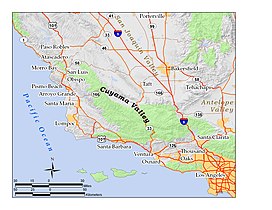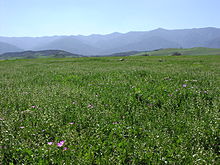| Cuyama Valley | |
|---|---|
 Rugged terrain surrounding the Cuyama Valley | |
 Location of the Cuyama Valley in southern and central California: green areas are national forests and national parks | |
| Area | 300 square miles (780 km2) |
| Geography | |
| Location | California, United States |
| Population centers | Cuyama, New Cuyama, Ventucopa |
| Coordinates | 34°55′46″N 119°35′50″W / 34.9295°N 119.5971°W |
| Traversed by | State Route 166, State Route 33 |
| Rivers | Cuyama River |
The Cuyama Valley ( Chumash: Kuyam, meaning "Clam") [1] is a valley along the Cuyama River in central California, in northern Santa Barbara, southern San Luis Obispo, southwestern Kern, and northwestern Ventura counties. It is about two hours driving time from both Los Angeles and the Santa Barbara area.
It is a sparsely inhabited area containing two primary towns – Cuyama and New Cuyama, and also Ventucopa. The land is largely used for ranching, agriculture, and oil and gas production. California State Route 166 runs along most of the east/west length of the valley, connecting the Kern County and the southern San Joaquin Valley with Santa Maria and coastal Santa Barbara and San Luis Obispo Counties. State Route 33 runs north/south through the eastern end of the valley, connecting the southern San Joaquin Valley with Ojai and coastal Ventura County.
Geography

The valley encompasses an area of approximately 300 square miles (780 km2). It is bounded on all sides by mountains: the Sierra Madre Mountains along the south and west, La Panza Range on the north, and Caliente Range along the northeast − all of the California Coast Ranges System; and the San Emigdio Mountains on the east − of the Transverse Ranges System.
The headwaters of the Cuyama River are just north of Pine Mountain Summit on State Route 33. The valley widens from the river's entry to a maximum width near the highway junction of Routes 166 and 33, near the corner of the four counties. Then it narrows again as the river flows west out of the valley through a narrow canyon between the Sierra Madre and La Panza ranges, to the Santa Maria Valley and its river mouth on the Pacific Ocean.
The agricultural fields are in the center of the valley, near the Cuyama Highway junction and the two primary towns, where the alluvium is rich and the valley is a wide floodplain. [2]
North of the major portion of the valley is the Caliente Range rises, over which is the Carrizo Plain, a much larger inland valley. To the southeast is the high backcountry of Ventura County, which includes the highest summit in the region, Mount Pinos and other features of the San Emigdio Mountains. The far eastern end of the valley the San Andreas Faultzone crosses, and forms a low jumble of hills which Route 166 passes over to reach the southwestern San Joaquin Valley, with Maricopa, I−5, and Bakersfield.
The Los Padres National Forest lands are adjacent to the Cuyama Valley on the south, east, and northwest sides. Much of the land to the northeast, including most of the Caliente Range, is managed by the U.S. Bureau of Land Management (BLM).

Geology
Geologically, the valley is an alluvium-filled synclinal basin, at an elevation of approximately 2,000 to 2,500 feet (600 to 800 meters). Most of the rocks are sedimentary, and the Miocene-age Monterey Formation outcrops to the south, in the foothills of the Sierra Madre. Pliocene and Pleistocene sedimentary formations occur in the foothills along the south side of the valley as well. The large Morales Thrust Fault separates the abruptly-rising block of the Caliente Range from the valley itself on the north. Scenic badlands occur in the upper reaches of the valley, north and northeast of Pine Mountain Summit; they are reachable from Route 33 via Lockwood Valley Road. [2] [3]
Climate
The climate of the valley is semi-arid with hot summers and cool winters. Almost all precipitation occurs in the winter in the form of rain, although snow has fallen on occasion; only five inches of rain falls annually on the valley floor, making it the driest place in coastal Central California. [4] Since the valley is open to the sea, there is occasional marine influence. The principal native vegetation on the valley floor is grassland and scrub, with chaparral and oak woodland in the hills to the south.
History

The native inhabitants of the valley are Chumash. The name "Cuyama" comes from a village named for the Chumash word kuyam, meaning "clam" or "freshwater mollusk". [1] In addition to kuyam, other Chumash communities in the Cuyama Valley included Sxaliwilimu’, Lishawato’w, and Tsiwikon. Although the Spanish arrived in 1769 in California, the Cuyama Valley Chumash had little interaction with the Spanish until 1801. Between 1801 and 1822, over 400 people from the Cuyama Valley were baptized into Spanish missions. Over half went to Mission La Purisima, while most of the others were incorporated into Mission San Luis Obispo, Mission Santa Ines, and Mission Santa Barbara—all Chumash missions. Pacomio was a Cuyama Valley man baptized into Mission La Purisima in 1803. The decade 1811 to 1822 was a period when Spain ceased to subsidize missions. This put pressure on native Christians to produce more and to pay a tax to sustain the suddenly unpaid military. As a result, Cuyama Valley people made a transition to mission life at a tense time. In 1824, Pacomio was a leader in the multi-mission Chumash uprising. In 1825, newly independent Mexico sent a governor to California who liberated accomplished craftsmen from mission life. Pacomio became a free carpenter in Monterey, the Mexican capital of California, where he served on the town council. He died in 1844 of smallpox. [5]
Near the end of the Mexican period of Alta California the valley was split into two land grants along the Cuyama River, the 22,193 acres (8,981 ha) Rancho Cuyama de Rojo in 1843, and the 48,827 acres (19,760 ha) Rancho Cuyama de Lataillade) in 1846. The main land use in the second half of the 19th century was cattle grazing, although some homesteading took place in the latter part, especially in the side canyons where there was more water. [6] In 1939, the first successful water wells using a pumping system were drilled. The groundwater aquifer is deep below the Cuyama Valley. The availability of irrigation water introduced agricultural crops into the region with the grazing of cattle continuing. [2]
Little further economic development took place in the Cuyama Valley until the discovery of oil in 1948 at the Russell Ranch Oil Field, and more significantly in 1949 at the much larger South Cuyama Oil Field. Richfield Oil Company, later part of ARCO, built the town of New Cuyama to house the oil workers and their associated services. They shipped the oil pumped from these two fields by pipeline to their refinery near Long Beach. For a brief time in the early 1950s, the Cuyama Valley was the fourth-most productive oil region of California. [2]
As oil production declined − only about two percent of the South Cuyama Field's oil is estimated to remain [7] − the main economic activity in the valley again became agriculture, [8] although with the sharp rise in the price of oil in 2007 and 2008, petroleum exploration has again been of interest.[ citation needed]
Recently E&B Natural Resources purchased the rights to develop the South Cuyama Oil Field from Hallador Petroleum.[ when?]
See also
References
- Charles W. Jennings and Rudolph G. Strand. Geologic Map of California, Los Angeles Sheet. State of California, Division of Mines and Geology. 1969.
- Dennis W. Lantis, Rodney Steiner, Arthur E. Karinen: California, Land of Contrast, 3rd edition. Kendall/Hunt Publishing Company, Dubuque Iowa. 1977. ISBN 0-8403-0768-3
Notes
- ^ a b Bright, William; Erwin G. Gudde (1998). 1500 California Place Names: Their Origin and Meaning. University of California Press. p. 46. ISBN 0-520-21271-1.
- ^ a b c d Lantis, Steiner, Karinen, p. 193-4
- ^ Jennings/Strand, Geologic Map of California, Los Angeles Sheet (1:250,000 scale).
- ^ Lantis, Steiner, Karinen, p. 194
- ^ John R. Johnson (2018). "Mission Recruitment and Community Transformations: An Ethnohistorical Study of the Cuyama Chumash" in Kathleen L. Hull and John G. Douglass, Forging Communities in Colonial Alta California. Tucson: University of Arizona
- ^ Bridgwater, Keri (2021-07-31). "The tiny cowboy town of Cuyama is Santa Barbara's best kept secret". SFGATE. Retrieved 2021-09-27.
- ^ California Department of Conservation, Oil and Gas Statistics, Annual Report, December 31, 2006, p. 67
- ^ Burns, Melinda (April 15, 2021). "Cannabis Industry Gains a Foothold in Parched Cuyama Valley". Noozhawk. Retrieved 2021-04-17.
External links
Cuyama Valley.